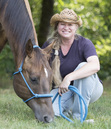Elena Hartwell's Blog, page 69
November 11, 2018
Award Winning Author Allen Eskens
Thrilled to have one of my favorite authors back on my blog to launch his latest novel. The Shadows We Hide is t he much anticipated follow up to The Life We Bury. You can read my last interview with Allen by clicking the link here.
Welcome Allen Eskens!
The Author
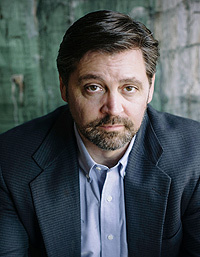 Bestselling author Allen Eskens is the recipient of the Barry Award, Minnesota Book Award, Rosebud Award, and Silver Falchion Award and has been a finalist for the Edgar® Award, Thriller Award, Anthony Award, and Audie Award. His books have been translated into 21 languages and his novel, The Life We Bury is in development for a feature film.
Bestselling author Allen Eskens is the recipient of the Barry Award, Minnesota Book Award, Rosebud Award, and Silver Falchion Award and has been a finalist for the Edgar® Award, Thriller Award, Anthony Award, and Audie Award. His books have been translated into 21 languages and his novel, The Life We Bury is in development for a feature film.
Allen has a journalism degree from the University of Minnesota and a law degree from Hamline University. After law school, he studied creative writing in the M.F.A. program at Minnesota State University-Mankato, as well as the Loft Literary Center and the Iowa Summer Writer’s Festival. Allen grew up on the hills of central Missouri. He now lives with his wife, Joely, in greater Minnesota where he recently retired after practicing criminal law for 25 years.
Allen is represented by Amy Cloughley of Kimberley Cameron and Associates Literary Agency.
To find out more about Allen, visit his website, follow him on Facebook, Twitter, and check out his Blog.
The Interview
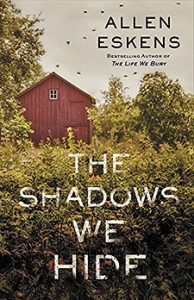 There were four years between your debut novel, The Life We Bury, and its sequel, The Shadows We Hide. In between, you published three books in the Max Rupert Series. What led you down these two roads? Why the series between the first book and your fifth?
There were four years between your debut novel, The Life We Bury, and its sequel, The Shadows We Hide. In between, you published three books in the Max Rupert Series. What led you down these two roads? Why the series between the first book and your fifth?
Thanks for this question, Elena. At the core of my writing is the hero’s journey. I want to see a character evolve and grow over the course of a novel (or trilogy), so that by the end of the story, the hero sees himself/herself or sees the world differently than they did at the beginning. In The Life We Bury, Joe survived a significant crucible. He wasn’t ready for another journey right away.
On the other hand, I saw a three-book arc for Max Rupert (a secondary character from The Life We Bury) that I wanted to pursue. By the end of those three books, Max would not only be changed, but emotionally and morally drained. However, over the course of those years, as Max’s story played out, Joe would become ready for his next journey. I also wanted time to pass so that Joe was in a different place in his life. Thus where Joe was in college in The Life We Bury, he is a reporter for the Associated Press in The Shadows We Hide.
“At the core of my writing is the hero’s journey.”
The Life We Bury and The Shadows We Hide revolve around amateur sleuth, Joe Talbert, while Max Rupert is a homicide detective. How different was it to write “mysteries” from both the professional and amateur perspectives?
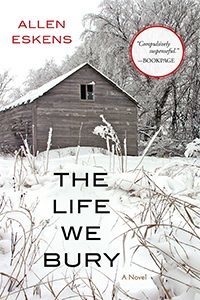 There is definitely a sharp contrast between writing for a detective versus writing for an amateur. Foremost is that the professional is supposed to be investigating crime—that’s his job. He has the means and the training. He has access to forensic labs and the panoply of tools developed for professional investigations.
There is definitely a sharp contrast between writing for a detective versus writing for an amateur. Foremost is that the professional is supposed to be investigating crime—that’s his job. He has the means and the training. He has access to forensic labs and the panoply of tools developed for professional investigations.
The amateur, on the other hand, is pulled into a mystery because of something personal that ties them to the crime—at least in my books that’s the case. He/she wants to see the matter solved because it is a need that must be fulfilled. Also, because there is no access to the professional accoutrements of crime fighting, the author must either find a way to give the amateur access to those tools, or must give the amateur sleuth some unique insight or knowledge that allows them to solve the crime—some special piece of information or experience that the professional investigators don’t have.
When you wrote The Life We Bury, did you know you wanted to write the second book?
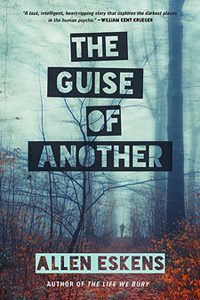 I didn’t foresee a sequel to The Life We Bury until I almost finished revising it. At that time it occurred to me that if I were to manage to get the book published, I might want to write a sequel. I could see the outline for that sequel even then, and I knew that it would not take place until after Joe was out of college. Because of that, I added specific passages to The Life We Bury that I knew would be important if there were to be a sequel. I’m glad that I put that thought into it because the sequel would have been much more difficult if I had not.
I didn’t foresee a sequel to The Life We Bury until I almost finished revising it. At that time it occurred to me that if I were to manage to get the book published, I might want to write a sequel. I could see the outline for that sequel even then, and I knew that it would not take place until after Joe was out of college. Because of that, I added specific passages to The Life We Bury that I knew would be important if there were to be a sequel. I’m glad that I put that thought into it because the sequel would have been much more difficult if I had not.
Also, as I write my stories, I create a world with multiple characters who all continue to live in my head. I contemplate what a novel for any one character might look like as I am writing that character for the current novel. That way, if I ever decide to tell a story about that particular secondary character, I’ve developed them enough that their story has a running start.
“It feels great to be a full-time writer.”
You recently retired after twenty-five years practicing criminal law. How does it feel to be a full time writer? Has your process changed?
It feels great to be a full-time writer. When I wrote my first four novels, I did very little other than work and write. Now, I am so much more relaxed, and I’m able to enjoy a little free time to chill with my wife and dogs. I enjoy the process of writing more now as well, although I have long enjoyed the pursuit writing, even before I started publishing my work. I have also become a big fan of taking naps.
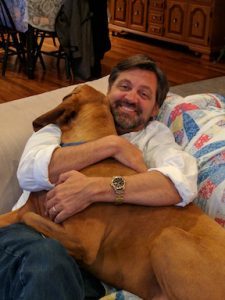
Your books are rooted in the Upper Midwest, specifically Minnesota. How does that environment, and the communities there, impact the characters and the stories they tell?
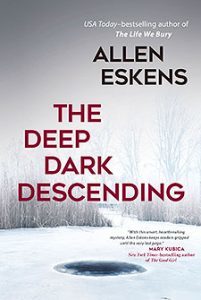 I like writing about Minnesota because there is a rich variety of both setting and environment to choose from. The Shadows We Hide has a strong tie to farmland, so it is set in the southwest part of the state. The Deep Dark Descending needed a scene of isolation, so I wrote that part of the story along the northern border. The Heavens May Fall played out in the metropolitan streets of Minneapolis and St. Paul. I can write stories that bake under the heat of the summer sun and others that force my characters to battle against the harshest winters that the country has to offer.
I like writing about Minnesota because there is a rich variety of both setting and environment to choose from. The Shadows We Hide has a strong tie to farmland, so it is set in the southwest part of the state. The Deep Dark Descending needed a scene of isolation, so I wrote that part of the story along the northern border. The Heavens May Fall played out in the metropolitan streets of Minneapolis and St. Paul. I can write stories that bake under the heat of the summer sun and others that force my characters to battle against the harshest winters that the country has to offer.
With that said, I just completed a manuscript that takes place in Missouri where I grew up. I needed to return to the world of my youth for that one.
What are you working on now?
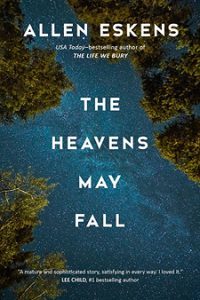 As I mentioned above, I just completed a manuscript for a story set in Missouri. It is the backstory of Boady Sanden, a character in both The Life We Bury and The Heavens May Fall. The story takes place in 1976 and recreates the world of my youth. I am also attempting to write the screenplay for that one before moving on to my next novel which will be a story for Lila Nash.
As I mentioned above, I just completed a manuscript for a story set in Missouri. It is the backstory of Boady Sanden, a character in both The Life We Bury and The Heavens May Fall. The story takes place in 1976 and recreates the world of my youth. I am also attempting to write the screenplay for that one before moving on to my next novel which will be a story for Lila Nash.
Lila is the love interest in The Life We Bury as well as The Shadows We Hide (she also had a supporting role in The Heavens May Fall). Over the course of five novels, she has grown in confidence and wisdom. She had some bad things that happened to her in her past, and having graduated from law school in The Shadows We Hide, I feel she is ready to delve into that traumatic history.
” . . . never stop learning.”
Final Words of Wisdom:
My final words of wisdom for writers would be to never stop learning. There is so much to this profession and craft that I don’t think that I’ll ever stop learning and improving. If writing is your passion—if you must write in order to be fulfilled—then take the time to understand the craft and never stop adding to that understanding.
Thanks for taking time out of your busy schedule to spend time with us here!
Looking forward to reading the new book!
The post Award Winning Author Allen Eskens appeared first on Elena Hartwell.
November 3, 2018
Three Debut Crime Writers: Three Independent Presses
Continuing my tradition of interviewing ITW Debut Authors, I’m thrilled to introduce Steven Max Russo, Liz Milliron, and Deirdre Feehan. All three authors demonstrate that Independent Publishers are viable paths for mystery/thriller/crime writers to follow.
Love to read about new authors? Don’t miss my earlier interviews with multiple debut authors. You can scan through my blog posts by clicking on the link here. You can also click on this link to read more.
The Author
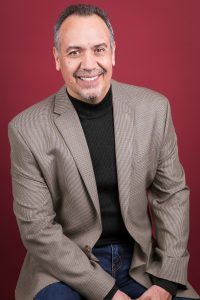 Steven Max Russo has spent most of his professional career as an advertising copywriter and agency owner. He got interested in writing fiction after one of his short stories was accepted by an online literary journal in 2013.
Steven Max Russo has spent most of his professional career as an advertising copywriter and agency owner. He got interested in writing fiction after one of his short stories was accepted by an online literary journal in 2013.
Then he caught the bug and began writing seriously. The publication of his first novel, THIEVES, has garnered praise from renowned crime and thriller authors from around the globe. With a gritty writing style and unique voice, he is quickly winning a legion of new fans. Steve is proud to call New Jersey his home.
Find out more about Steven by visiting his website and following him on Amazon
The Book: Thieves
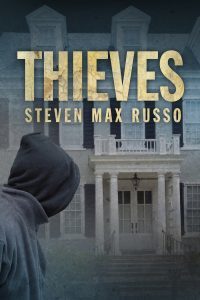 Thieves is about a simple home invasion and robbery that goes terribly wrong. A young woman trapped by both circumstance and greed finds herself forced to fight for her life against a dangerous psychopath. It’s a gritty story written in a somewhat noir style that really has no “good” characters in it — just different degrees of bad.
Thieves is about a simple home invasion and robbery that goes terribly wrong. A young woman trapped by both circumstance and greed finds herself forced to fight for her life against a dangerous psychopath. It’s a gritty story written in a somewhat noir style that really has no “good” characters in it — just different degrees of bad.
To buy the book, click on one of the following links:
• Amazon — Trade Paperback | eBook
• Amazon UK — Trade Paperback | eBook
• Barnes & Noble — Trade Paperback | eBook
• IndieBound — Trade Paperback
• iTunes — eBook
• Kobo — eBook
• Play — eBook
The Interview
Describe your publishing journey:
I guess like for a lot of debut authors, it’s been a long, hard journey. Thieves is my first novel. I secured an agent fairly quickly, but he left his literary agency just a few weeks after taking me on to start his own firm and, because of legal considerations, dropped me along with some of his other clients. My second agent shopped the manuscript but couldn’t secure a deal. After a while I felt like she gave up on it (and on me), so we parted ways. I had trouble finding another agent to take me on and then my friend and mentor, the writer Charles Salzberg, introduced my work to his publisher at Down & Out Books and here I am.
What inspired you to write this novel?
My wife and I were on vacation and walking the beach on Sanibel Island, FL. We were absently talking about what we would do if we ever got the chance to retire. I had sold my first short story the year before and I told her that instead of taking up golf, I might attempt to write a novel. She looked at me and asked, “Why wait?” Hmmm, I thought, why indeed? So I started writing the day we got back home and three months later the first draft of Thieves was finished.
What are you working on now?
My second novel, THE DEAD DON’T SLEEP, is due out from Down & Out Books in early 2019. It’s a thriller about an ex special ops soldier from the Vietnam War, now nearing 70, who finds himself being hunted by a squad of psychopaths that he helped train during the war. I am also currently putting the finishing touches on my third novel tentatively titled THE DEBT COLLECTOR about a young woman who collects outstanding debts for low-end bookies and mobsters. It’s a fast, fun read with a charming yet violent character named Abigail Barnes whom I just fell in love with.
The Author
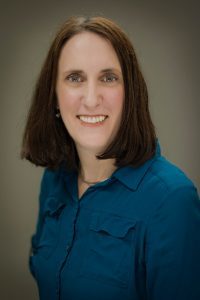 Liz Milliron has been making up stories, and creating her own endings for other people’s stories, for as long as she can remember. She survived growing up through reading, cutting her mystery teeth on Agatha Christie, Mary Higgins Clark and, of course, Nancy Drew.
Liz Milliron has been making up stories, and creating her own endings for other people’s stories, for as long as she can remember. She survived growing up through reading, cutting her mystery teeth on Agatha Christie, Mary Higgins Clark and, of course, Nancy Drew.
As an adult, she finds escape from the world of software documentation through creating her own fictional murder and mayhem. She is a member if Sisters in Crime, International Thriller Writers, and Pennwriters. She lives near Pittsburgh with her husband and two teenage children, and fantasizes about owning a dog – one of these days.
Find out more about Liz on her Website, Facebook, and Instagram
The Book: Root of All Evil
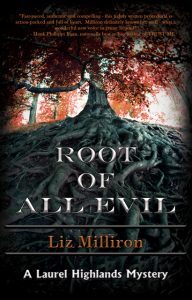
Finding a drug dealer and shutting down a meth lab should be just another day at the office for Trooper Jim Duncan. Discovering her co-worker’s secret shouldn’t trouble assistant public defender Sally Castle too much, either.
But when their investigations collide, they’ll find themselves in the middle of scandal – and put Sally in a killer’s crosshairs.
To buy the book, click on one of the following links: Amazon & IndieBound
The Interview
Describe your publishing journey:
Long. This novel started as a personal NaNoWriMo challenge in 2013. After two rewrites, I decided in May of 2015 it was ready to start querying. After a year, a few nibbles, and countless rejections, I decided to let my current critique group take a look at the book. Maybe it wasn’t as ready as I thought. What I hoped were going to be tweaks turned into another full rewrite, which led to another year of querying, again with no results. I moved on to small presses that didn’t require agented submissions. Still no luck. Then a couple friends of mine announced deals with Level Best Books. I researched them and asked for advice from Annette Dashofy, one of my critique partners (and someone whose writing I admire a lot). She said go for it, so I did. I decided, however, that if Level Best passed, this series simply wasn’t meant to be and I’d move on to something else.
I went from query to three-book contract in less than a month. So nothing, nothing, nothing, BAM! is a very apt description.
What inspired you to write this novel?
I said this was a personal challenge. I’d written one novel that is in a drawer where it belongs. I’d written several short stories with these characters, but could I write a novel? I waited for the right idea. Then one day I was walking down a sidewalk (or standing in a shop, I can’t remember exactly) and I overheard someone on a cell phone say, “You’d better fix this. Or else!” Of course that got my brain off and running, and the novel was born.
What are you working on now?
Two things, actually. I’m polishing up the second novel in the series, Heaven Has No Rage, which is scheduled for release in August 2019. At the same time, I’m working with my critique group on the third book, Broken Trust, scheduled for release in August 2020. Yes, I’m a bit of an overachiever.
The Author
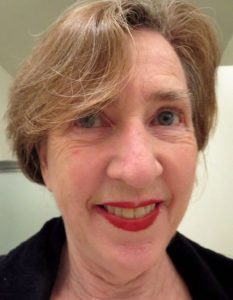 Deirdre Feehan is a writer, librarian, and native of California. She travelled extensive in Europe and resided in London for a time. She completed the UCLA’s Writer’s program in 2009, specializing in fiction. Her recent work includes an essay on Sir Carol Reed for the Senses of Cinema database, a photographically illustrated children’s book, ABC starring Teddy and his friends, short stories in magazines and online ‘zines, and two poems, Orpheus & Eurydice: Two letters, in the online journal, Slow Trains.
Deirdre Feehan is a writer, librarian, and native of California. She travelled extensive in Europe and resided in London for a time. She completed the UCLA’s Writer’s program in 2009, specializing in fiction. Her recent work includes an essay on Sir Carol Reed for the Senses of Cinema database, a photographically illustrated children’s book, ABC starring Teddy and his friends, short stories in magazines and online ‘zines, and two poems, Orpheus & Eurydice: Two letters, in the online journal, Slow Trains.
She received honorable mentions in the 2015 Soul-Making Keats Literary Competition for her unpublished novel, Aldo’s resume and in the 2015 Ultra-Short Competition sponsored by The Binnacle at The University of Maine at Machias. Taylor on loan is her first foray into crime fiction.
To learn more about Deirdre click here for her publisher page and follow her on Amazon
The Book
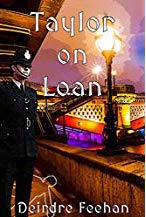 After finding a banker hanging from Blackfriar’s bridge, a young officer is used by the London Metropolitan Police to expose the money laundering and murder being perpetrated other officers.
After finding a banker hanging from Blackfriar’s bridge, a young officer is used by the London Metropolitan Police to expose the money laundering and murder being perpetrated other officers.
Buy the book on Amazon, and Barnes & Noble
The Interview
Describe your publishing journey:
I began the work in 1995 and read one of the chapters at a writers’ conference in Holland in 1997. The other writers there were very disturbed by the violence of the scenes. The work was radically rewritten while I attended UCLA’s writers’ program from 2006-2009. Though I queried twelve agents about publication in 2009, only John A. Ware was interested.
He and I worked together by email and phone, resculpting the manuscript toward publication. After his death, I queried many agents but none was interested. My teacher, Michael Buckley, suggested a number of publication avenues, one of which was Black Opal Books. They accepted the work in 2017. Further editing occurred between acceptance and publication in 2018.
What inspired you to write this novel?
In 1982 an Italian banker was found hanging from Blackfriar’s bridge in London. The Metropolitan police initially ruled the death a suicide. I knew immediately based on the location (a heavily traveled, brightly painted bridge over the Thames) that that assessment was a lie. I began to formulate a story based on why the police would make such a ludicrous announcement.
What are you working on now?
I am writing a third novel featuring several of the main characters from my debut novel, Taylor on loan. Set in Amsterdam, the novel explores how and why these various police officers meet and begin working together on international fraud. It all begins with a jeweler’s death in Amsterdam.
Thank you all for joining me today on my blog – Congratulations on your debut novels!
The post Three Debut Crime Writers: Three Independent Presses appeared first on Elena Hartwell.
October 28, 2018
Math Genius turned Stuntwoman turned Bestselling Author
This week I’m branching out a bit from my usual Mystery/Thriller/Suspense authors to include a Sci-Fi thriller writer! Introducing S.L. Huang.
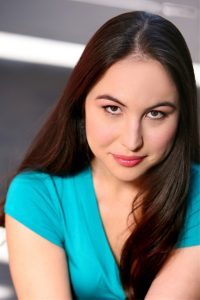 The Author
The AuthorS. L. Huang has a math degree from MIT and is a weapons expert and has worked as a professional stuntwoman on Battlestar Galactica and a number of other productions.
Her short fiction has appeared in Strange Horizons, Nature, Daily Science Fiction , and The Best American Science Fiction & Fantasy 2016 .
To learn more about S.L. find her website by clicking the link here.
The Book
Meet Cas Russell: a retriever with special skills, she can take any job for the right price…until she takes the wrong one.
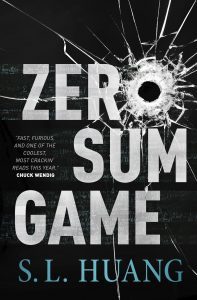 This near-future science fiction thriller features a mercenary whose genius level math prowess gives her superhuman abilities: taking down men twice her size and dodging not just fists, but bullets, too.
This near-future science fiction thriller features a mercenary whose genius level math prowess gives her superhuman abilities: taking down men twice her size and dodging not just fists, but bullets, too.
If you liked Trinity from The Matrix but could do without the blind devotion, meet Cas Russell.
As far as Cas knows, she’s the only person around with a superpower, and she’ll take any job for the right price. Then, she discovers someone with a power even more dangerous than her own.
Someone who can reach directly into people’s minds and twist their brains into Moebius strips.
Someone intent on becoming the world’s puppet master. Cas should run, like she usually does, but for once she’s involved. There’s only one problem: she doesn’t know which of her thoughts are her own anymore.
You can find the book through the following links:
Amazon
Barnes and Noble
Books a Million
IndieBound
The Buzz
“Huang’s series starter will have readers anxiously awaiting the next…A fast-paced, darkly humorous read with a lot of heart for fans of action and urban fantasy, as well as lovers of Wolverine and other morally ambiguous, gritty superheroes with a mysterious past.” — Booklist, STARRED review
“This hard-to-put-down, action-packed SF debut is intelligent and entertaining. With Cas, Huang has created an indelible, flawed character who makes mathematics seem almost magical.” — Library Journal, STARRED review
“Cas is an awesome antiheroine, sympathetic despite her practical approach to violence, and her abilities make this book exciting, nasty fun…an excellent harbinger for books to come.” — Kirkus Reviews
“Fast, furious, and one of the coolest, most crackin’ reads this year.” — Chuck Wendig
“Cas Russell is who I want to be when I grow up. She kicks ass with her fists and her brain—a true twenty-first century action hero. I loved this book.” — Richard Kadrey
“The best novel I’ve read this year; a heroine I fell in love with.” — Eric Van Lustbader
“Intense, vivid, and insanely clever, with a great heroine. I couldn’t put it down.” — Yoon Ha Lee
“The smartest and thrillingest book you’ll read all year.” — Ken Liu
“A flat-out sprint.” — Kate Elliott
Fun Facts
S.L. . . .
. . . has worked with actors such as Jason Momoa, Sean Patrick Flanery, and Danny Glover.
. . . has a degree in mathematics from MIT and her favorite kinds of math are abstract, theoretical, and useless.
. . . is the first professional female armorer in the film and TV industry. A licensed armorer decides what type of weapons fit a production and coaches actors on how to use them.
. . . is a two time cancer survivor.
. . . taught computer science at Zhejiang University and the Dalian Institute of Technology in China. Then proceeded to backpack across the country, including sharing a tent with a baby yak.
. . . is an amateur trapeze artist and car drifter. Yes, like in “Tokyo Drift.”
Header Photo: by Deepak Gautam from Pexels
The post Math Genius turned Stuntwoman turned Bestselling Author appeared first on Elena Hartwell.
October 21, 2018
Quiet the Inner Critic and Learn to #CHILL
This week I’m thrilled to turn my blog over to guest blogger, Bryan E. Robinson to help us with a problem most writers face at some time in their career: The inner critic.
 Bryan is a licensed psychotherapist and author of two novels and 40 nonfiction books. He applies his experiences to crafting insightful nonfiction self-help books and psychological thrillers. His multi-award winning southern noir murder mystery, Limestone Gumption, won the New Apple Book Medal for best psychological suspense, the Silver IPPY Award for outstanding mystery of the year, the Bronze Foreword Review INDIEFAB Book Award for best mystery, and the 2015 USA Regional Excellence Book Award for best fiction in the Southeast.
Bryan is a licensed psychotherapist and author of two novels and 40 nonfiction books. He applies his experiences to crafting insightful nonfiction self-help books and psychological thrillers. His multi-award winning southern noir murder mystery, Limestone Gumption, won the New Apple Book Medal for best psychological suspense, the Silver IPPY Award for outstanding mystery of the year, the Bronze Foreword Review INDIEFAB Book Award for best mystery, and the 2015 USA Regional Excellence Book Award for best fiction in the Southeast.
His most recent release is Daily Writing Resilience: 365 Meditations and Inspirations for 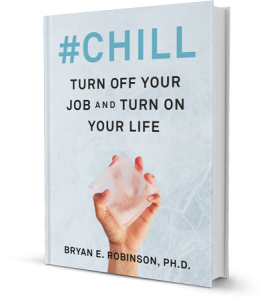 Writers (Llewellyn Worldwide, 2018). He has written for Psychology Today, First for Women, and Natural Health, and his blogs and columns for writers appear in Southern Writer’s Magazine.
Writers (Llewellyn Worldwide, 2018). He has written for Psychology Today, First for Women, and Natural Health, and his blogs and columns for writers appear in Southern Writer’s Magazine.
He is a consulting editor for The Big Thrill, the online magazine for International Thriller Writers. His long-selling book, Chained to the Desk, is now in its 3rd Edition (New York University Press, 1998, 2007, 2014). His books have been translated into thirteen languages, and he has appeared on every major television network: 20/20, Good Morning America, ABC’s World News Tonight, NBC Nightly News, NBC Universal, The CBS Early Show, CNBC’s The Big Idea. He hosted the PBS documentary, Overdoing It: How to Slow Down and Take Care of Yourself.
Next up for Bryan: #CHILL: Turn off your job and Turn on your life
To learn more about Bryan, you can find him on Facebook, Twitter, and LinkedIn
“What a relief to learn that the voice in your head isn’t who you are.”
#Chill: Tune Out Your Inner Critic and Tune Into Your Writing
Do you hear voices in your head? Of course you do if you’re a writer. All of us authors have one relentless voice, in particular, that lives in our heads and never rests—an inner critic that puts us under the microscope, bludgeons us with criticism, and tells us how worthless, selfish, dumb, or inept we are. That kick-butt voice pops up like burnt toast with such lightning speed we don’t even notice, eviscerating us with name-calling, discouragement, and putdowns.
The inner bully tells you that you can’t; you should, ought to, have to, or must. Psychotherapists call it “musturbation.” The Critic knows where you live and where to find you. And it does. When you’re working on an important manuscript, it stalks you to your desk and whispers over your shoulder. It could be scolding you right now. Listen closely. Do you hear it: “No, that’s not right! You don’t know what you’re doing! You might as well give up! Who do you think you are, Stephen King? J.K. Rowling? You’re an imposter.”
Burnt toast anyone?
Here’s how to chill your inner bully. When it pops up, befriend it. You heard me right. Listen to it with a curious, dispassionate ear as a part of you. Imagine someone scolding you over your cell phone, and you hold the phone away from your ear. In the same way, you can hold the Critic’s message away from you and listen to it from afar as a separate part from you, not all of you. In addition to hearing it as a part of you, not you, a dispassionate ear gives you distance from the Critic’s voice and keeps you from identifying with it or attacking yourself. Plus it keeps you from believing the voice’s made-up story.
What a relief to learn that the voice in your head isn’t who you are. It’s the lowercase “self.” Who are you, then? You’re the True Self with a capital “S”—the one who hears and sees the lowercase “self.” The uppercase YOU is composed of 8 “C” words: Creative, Curious, Clarity, Calm, Confident, Courageous, Connected, and Compassion. When you put yourself into one of the “C” states, it automatically triggers some of the others. For example, if you can get curious, it often activates clarity then calm. Or when get calm or confident, it unleashes creativity.
There’s no use fighting, debating, or arguing with your inner bully. It always has a comeback and always wins, plus you can’t get rid of it. Instead you can watch it and let it come and go without personalizing it. When you oppose or try to reason with the Critic, you give it credence and, instead of streaming on through, it takes up residence.
Studies show when you come down hard on yourself after a publisher’s rejection or a harsh review, it reduces your motivation and chances of success. It’s just as easy to affirm yourself with positive messages, as it is to tear yourself down with negative ones. We become proficient at what we practice on a regular basis.
“If your Critic is keeping you stuck, try replacing it with Self-compassion”
If your Critic is keeping you stuck, try replacing it with Self-compassion (from the capital Self) each step of the way. Experts say that self-compassion is a powerful resilient tool that stands up to harm and is more likely to lead to untold heights of success. So put down your gavel and amp up your kinder, compassionate side. And in times of writing struggles, give yourself pep talks, positive affirmations, and talk your self off the ledge instead of letting your Critic encourage you to jump.
Vincent Van Gogh once said, “If you hear a voice within you say, ‘You cannot paint,’ then by all means paint, and that voice will be silenced.” I’m no Van Gogh, but Dr. Bryan Robinson says, “If you hear a voice within you say, “You cannot write or speak in front of fellow authors,” then by all means do it, and that voice will be silenced.”
And that’s a promise!
The post Quiet the Inner Critic and Learn to #CHILL appeared first on Elena Hartwell.
October 14, 2018
Award Winning Author Dana Chamblee Carpenter
This week I’m hosting the amazing Dana Chamblee Carpenter. Her cross-genre Bohemian Trilogy has won multiple awards, as has her short fiction. She’s here to celebrate the launch of the third installment, Book of the Just. Welcome Dana!
The Author
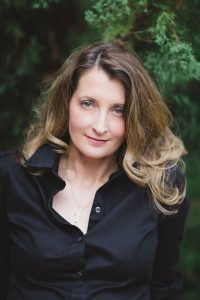
Dana Chamblee Carpenter: In addition to the Bohemian Trilogy, Carpenter’s award winning short fiction has appeared in The Arkansas Review, Jersey Devil Press, Maypop, and, most recently in the anthologies, Dead Ends: Stories from the Gothic South, and Killer Nashville Noir: Cold Blooded.
An Arkansas native, Carpenter received her Ph.D. in English from the University of Mississippi. Though initially lured by the pragmatic academic world, Carpenter secretly nurtured her dream of writing stories, and, once the dust had settled on the dissertation, she gave herself over to what she’d known since she was a child—she was meant to be a storyteller.
She currently teaches creative writing and American Literature at a university in Nashville, TN, where she lives with her husband and two children, who are desperately trying to turn the house into a model of Luna Lovegood’s eccentric home with glass beads and bells and little figures nestled into every nook and cranny. Hopefully there aren’t any exploding dragon horns.
You can find Dana on Facebook and Twitter
To buy books, click on the link here.
The Interview
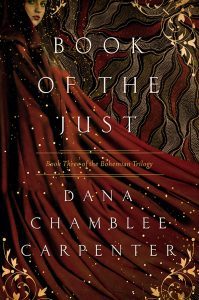 Your latest novel, Book of the Just, is book three of your Bohemian Trilogy. Does this mean you are finished with these characters? Or can we anticipate seeing more of them?
Your latest novel, Book of the Just, is book three of your Bohemian Trilogy. Does this mean you are finished with these characters? Or can we anticipate seeing more of them?
I was waiting for someone to ask me this! No, we’re not done with Mouse (or some of the other characters) at all. I already have two books started that give us an idea of what Mouse was up to in that 700-year gap between Bohemian Gospel and The Devil’s Bible. (We go looking for what we can discover about Mouse’s mom in one of them.)
And though I did think I was done with any stories that would come after Book of the Just, the very night I finished the first draft, one of the characters we meet in this novel started whispering in my ear. But I’ve got another couple of books I need to finish before I can go back into Mouse’s world. There’s just not enough time!
Your novels span fantasy, mystery, historical fiction, literary … thriller … how would you characterize your work? How did you come up with such an evocative blend?
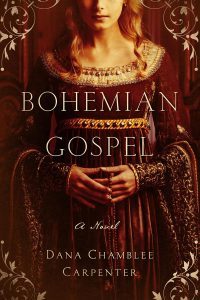 I write what I love to read, and I read almost everything. I find I am especially drawn to books that don’t color inside the lines of genre too carefully. I like a dose of magic or a thrill in my historical fiction. I want the beautiful words of literary works to also sweep me away with story—mystery or magic. I want fantasy that’s grounded in reality.
I write what I love to read, and I read almost everything. I find I am especially drawn to books that don’t color inside the lines of genre too carefully. I like a dose of magic or a thrill in my historical fiction. I want the beautiful words of literary works to also sweep me away with story—mystery or magic. I want fantasy that’s grounded in reality.
I like to think of my novels as genre-defiant. Publishers think readers want the same thing, time after time, but I think readers want the familiar presented to them in unfamiliar ways OR something unfamiliar couched inside their usual expectations, something that shakes up the familiar a bit. I’ve been rewarded to hear from readers who picked up Bohemian Gospel thinking it was straight historical fiction and who were surprised to find the paranormal in there, too.
They loved it. Likewise, lots of fantasy readers who thought they’d never want to read historical fiction have fallen in love with the rich, historical detail. I think most of us understand that life’s not neat and tidy and something we can easily label and put on a shelf—or at least don’t want life to be that way. I don’t think we want our novels that way either.
Research plays a huge role in your work. What is your process like? How much do you use research for inspiration and how much do you include as factually as you can?
I’m always following where the character leads. If I start with the research, it smothers the story and strangles the characters, so I let them take me where they need to go. When the characters show me some place or time that’s new to me, that’s when I start researching. I run down more than a fair share of research rabbit holes, but it all fires my imagination and colors the tone and backdrop of the story even if it doesn’t make it more directly into the book. I have SO many details stored away in my head that never see the printed page.
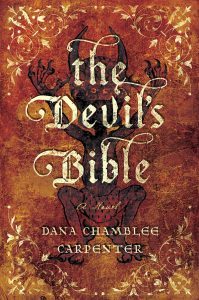 As you say, accuracy is the goal that drives my research. With Bohemian Gospel, I wanted to reflect the complex culture of the time and place, and I felt a responsibility to get the historical figures as “right” as I could. But I actually felt more pressure researching for Book of the Just. When we start, Mouse is hanging out with the indigenous people of Australia, learning their culture and the stories of the Dreaming.
As you say, accuracy is the goal that drives my research. With Bohemian Gospel, I wanted to reflect the complex culture of the time and place, and I felt a responsibility to get the historical figures as “right” as I could. But I actually felt more pressure researching for Book of the Just. When we start, Mouse is hanging out with the indigenous people of Australia, learning their culture and the stories of the Dreaming.
Not only did I want to be accurate, but I also wanted to be sure that I handled the material respectfully—careful to use the Martu language to recount the storylines of the Dreaming and to only tell the parts that they had publicly shared (many of their stories are meant only for their particular group or family, though researchers over the years have co-opted the stories).
I know I’m going to make mistakes in the writing—heck, if Eudora Welty gets called on putting the moon in the wrong place on a specific night, I know I’m in for my share of “gotchas.” But I try my best to get the important things right.
Short stories and novels are similar in many ways and yet so different in others. How does the process of writing differ for you between the two? What are the pros and cons for writers working with both?
Oh my, you are SO right. I find short stories to be much more difficult to write, but the constraints of shaping a complete arc in such a short span really makes me hone my skills so I keep working at them. Short stories force the writer to be efficient, to make a word or action or dialogue do more than one thing at a time. That efficiency can really be helpful in writing a novel, too, but most of us don’t do it because we have the space and time to meander more lazily. I also find that I focus more on story/plot in short fiction. In a longer work, I can let the characters drive the action and show me where we’re headed, but in a short story I feel like I’m always telling them to hurry up!
If you could live at any time in the past, when/where would it be and why.
I always thought it would be Arthurian times in Ireland or Scotland because I grew up devouring stories about that era—though I’m pretty sure I’d want to be a dude if I lived then. No princesses for me. I’d like to be a druid.
But something a little uncanny happened when I was researching 13th Century Bohemia—I felt like I’d come home, like I was rediscovering a place rather than learning about it for the first time. As far as I know, my ancestors were all French and Irish with some plain working-class English blokes tossed in the mix, but I felt haunted by Bohemia. I’d still want to be a dude. I’d like to fight for the just causes Ottakar II took up in his day.

What are you working on now?
I’m doing a first set of revisions on book one of a new series that focuses on a family with seven girls, all of whom are witches but one. They live in the Mississippi Delta in the 1920s at the time of the great flood when the river broke through the levees. It’s Southern and gothic and full of a bunch of don’t-mess-with-me-or-mine sisters.
Final words of wisdom:
Don’t quit. You’re going to want to some days. I do. You’re going to hear voices of doubt in your head that tell you you’re no good, that you’re a fraud. I do—even after three novels, awards, and published short stories. Some days your words will come fast and furious and will be satisfying and good. Some days the blank screen will mock you. Or your day, eaten by all the other obligations in your life, will taunt you. You’ll think about how easy it would be to give it up. Don’t do it. Don’t quit. Breathe a bit. Fill your well with something childlike and fun. Then turn back to your characters, and let them whisper their stories to you.
Excellent advice!
Thank you for hanging out with us!
Looking forward to seeing what happens next for you and your marvelous characters.
The post Award Winning Author Dana Chamblee Carpenter appeared first on Elena Hartwell.
October 7, 2018
#NotMyCat on Author James L’Etoile
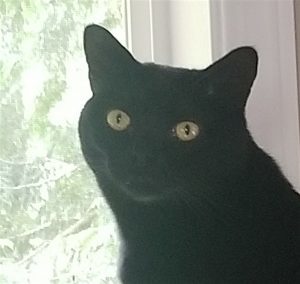 Hi Readers! My name is Coal Train and I own author Elena Hartwell. She’s been very busy lately, so I thought I’d highjack . . . I mean, fill in for her, on her blog this week. To do that, I picked the perfect accomplice . . . I mean, subject, for my interview.
Hi Readers! My name is Coal Train and I own author Elena Hartwell. She’s been very busy lately, so I thought I’d highjack . . . I mean, fill in for her, on her blog this week. To do that, I picked the perfect accomplice . . . I mean, subject, for my interview.
Author James L’Etoile has the lucky distinction of being chosen by a cat. And not just any cat, but a cat who has become an internet sensation: The one and only #NotMyCat. I’m so excited to interview this amazing feline.
The Author
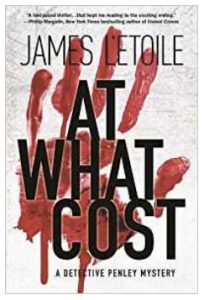
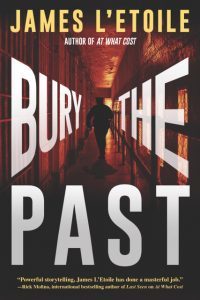
James L’Etoile is the author of At What Cost and Bury The Past available online and at bookstores and libraries near you. To learn more about James, click on the link here.
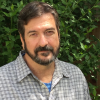
To read my interview with James about his writing, click the link here.
Buy Links for At What Cost
Buy Links for Bury The Past
The Interview
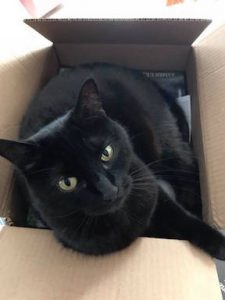
#NotMyCat, I love to see your posts on Facebook and Twitter. How did you become so popular on social media?
Hi, CT. Can I call you CT? ‘Cause you seem like the kind of cat that would go by a cool nickname. Anyway, the social media thing started when I snuck onto the author’s computer. I saw he was telling everyone all that I’m “not his cat” garbage. Like he has a choice. So, I started to make sure he knew I wasn’t about to go anywhere. The lady who claims she’s my owner lives a few houses down. She’s nice enough, but she’s gone almost all day—and I have needs. When the author isn’t looking I sneak on and log into my own Twitter and Facebook pages.
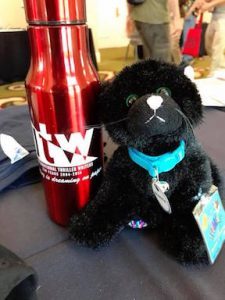
Both our authors travel a lot, and no matter how much I try to sneak into her luggage, she always finds me. I’ve noticed your author is now traveling with a stunt double for you, have you made any plans to kill the stunt double and go in his place on future travels?
Yeah, he’s been gone a lot from Toronto, to Reno, New York, San Francisco, and Florida. The stunt double was actually my idea. Do you have any idea how much work it would be for a Diva like to me pack all the toys, catnip, and my cat “unmentionables?” Not to mention the crate they think I would have to ride in while he jets around. That just ain’t happening. No one puts this cat in a cage without getting a scratch or two. Besides, he can be out doing whatever it is that he does, and I can lounge around the house and fully claim it for my own.
Finding the right person is tricky, how did you choose your author?
CT, you are so right! I thought I found a family with two little boys that would pay attention to me. After my background check of sneaking in their house, getting a lay of the place, and figuring where I could sleep inside, I decided they weren’t the right fit. They were way too manic and busy to support my need for tranquility. I found the author sitting in the backyard writing. So, while he was occupied, I snuck inside through the dog door. The Corgi who lives there is a little intimidated by my lustrous black fur and let me pass. I felt a little like the Goldilocks character, moving from bed to bed until I found just the right one.
The author found me there and took my photo. He likes to capture my likeness in all my feline glory.
With the author around, I always have someone to scratch my chin as it should be scratched. I have needs. Have I mentioned that yet?
I find the best way to interrupt my author’s writing time is to climb up on the desk and run around between her computer screen and the window, what are some of your favorite ways to derail your author’s writing process?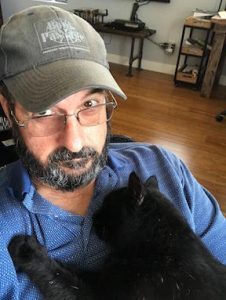
It depends on how the author happens to be writing. If he’s writing out something longhand, I find sitting on his notepad and grabbing the pen with my teeth will get my message across. That message is pet me—only me. If he happens to be using the keyboard, I will sit my furry little butt right on the keys. It makes a strange clinking sound when I do that—now that I think of it, the author makes a sound when I do that. It doesn’t sound nice.
Even though I often create chaos and confusion for my author, I am an important part of her rewriting process. I know my interruptions force her to take a break, curse, and walk away from the computer. What do you bring to the table to help your author as he rewrites?
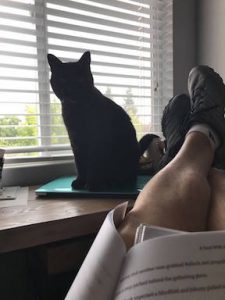 I supervise the entire creative process. I think as myself as the creative force behind everything he’s working on. If I don’t approve of a word, or a plot direction, I will do what I need to do to get my artistic vision across. That may range from knocking the pen off his desk, laying on the copy so he can’t see his notes, climbing in his lap so he has no choice but to slow down and type one handed (because he’s petting me with the other), or, in desperate circumstances, I will grab him around the neck to shake him out of his ways. Claws may be used when I really need him to stop and listen.
I supervise the entire creative process. I think as myself as the creative force behind everything he’s working on. If I don’t approve of a word, or a plot direction, I will do what I need to do to get my artistic vision across. That may range from knocking the pen off his desk, laying on the copy so he can’t see his notes, climbing in his lap so he has no choice but to slow down and type one handed (because he’s petting me with the other), or, in desperate circumstances, I will grab him around the neck to shake him out of his ways. Claws may be used when I really need him to stop and listen.
Since we are both left behind so often, what are some of your favorite ways to pass the time when your author is gone?
I fancy myself as a bit of an explorer. I’ll wander about the neighborhood and receive their adoration. Then I’ll eat tuna at the home of the woman who thinks she owns me. I’ll return to the author’s house and sleep on the grass. It’s too much work to go chase down the birds that make it impossible to sleep with their incessant chirping, so I’ll go in through the dog door and find a new quiet place to nap. I’ve been using the dog’s bed lately and it’s very comfy.
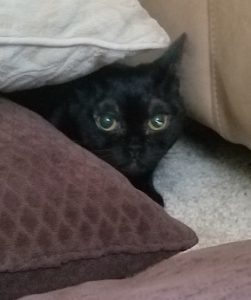 Hi #NotMyCat, I’m Coal Train’s little sister, Cocoa. Coal Train has been a lot happier since I arrived in the house. Do you have any brothers or sisters?
Hi #NotMyCat, I’m Coal Train’s little sister, Cocoa. Coal Train has been a lot happier since I arrived in the house. Do you have any brothers or sisters?
I’m the only cat in this house and that’s one of the reasons I chose it. I have no feline competition for attention or napping space. In fact part of my daily duties include chasing any other stray mangy cats away from the author’s house. I found it and it’s all mine. Well, I do have to share it with Emma the Corgi. She’s nice enough and doesn’t chase me like other dogs. She and I have an agreement, I won’t go in certain rooms that the Dog claims are hers, and she lets me camp out in the guest rooms—and anywhere else I please. Sometimes we go on walks together.
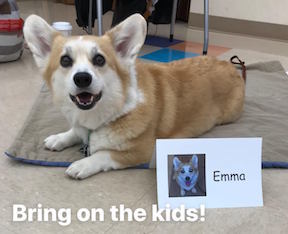
Emma does her part to make the world a little better – she works as a therapy dog and participates in events, such as Read to the Dogs, at her local library. She loves to work with kids!
Sorry about the interruption, #NotMyCat, Cocoa is always butting into things when I’m working. I have to admit though, I have trained her well. She has learned the art of climbing into my author’s lap and looking so cute, my author has to stop working and pet her instead.
Looking cute is part of being an author’s cat. I can sit in a box like nobody’s business. I own that box. The author is kind of needy, so I find I have to go out of my way to let him know I care. I’ll meet him for coffee in the morning before the sun comes up. Before. The. Sun. Comes. Up. If that doesn’t say I care, Don’t know what does. Then after he gets his first cup, I can slink off and take a nap—until I need to check his work.
One last question before I go and drag papers off my author’s desk and then take a nap in the sun. What is your author working on now? Can you tell us something no one else knows about him?
He should be working on a cat book. I mean come on, I’ve giving him all the hints here. Actually, the author has been a busy one. He has three standalone novel manuscripts done and working with his agent to place them with the right publisher. He will have two short stories released in upcoming anthologies in the next few months, and he’s writing a new novel in which he’s promised me that it will have a black cat wander through the pages. As far as something about him—hmmm—everybody knows he worked in prisons for years—It’s kinda like a animal shelter, but for bad people—but not too many people know he plays an awful guitar. The guitars are fine, but the noise he makes with them make me want to go chew on the strings.
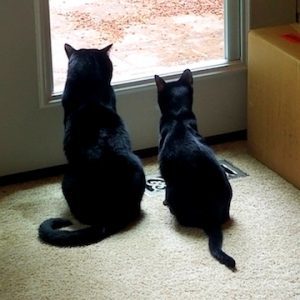
Thanks for hanging out with us #NotMyCat! Cocoa and I look forward to following your future adventures!
The post #NotMyCat on Author James L’Etoile appeared first on Elena Hartwell.
September 30, 2018
A New Holiday Cozy From Mary Angela
I love the holidays. It’s such a beautiful time of year. I love leaves changing color, the first snowfall, and cozy holiday novels! I feel very merry hosting author Mary Angela on the launch of A Very Merry Murder (Oct 1). The third book in her Professor Prather Mystery Series.
The Author
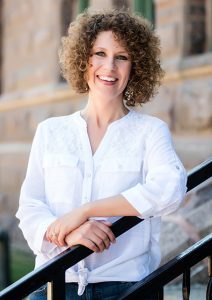
© Julie Prairie Photography 2016
Mary is a mother, writer, teacher, and lover of books—literary and otherwise. She first experienced genre confusion when one of her own professors asked what type of writing interested her, and she answered “historical romance.” (She meant fiction or nonfiction.)
Although she never pursued a career as a romance writer, she did follow her dream of writing a traditional mystery. Set in the Midwest, the Professor Prather academic series captures her love of the Great Plains and university life.
To learn more about Mary Angela, click the link here.
You can also follow her on Facebook and Twitter
All the books in the series are available on Amazon, Barnes& Noble, and IndieBound
The Interview
 Your amateur sleuth is a college professor. How much do you draw on your own experiences as a college professor for the series?
Your amateur sleuth is a college professor. How much do you draw on your own experiences as a college professor for the series?
I draw on them a lot. An event will take place on campus, and I’ll think, that would be a great setting for a murder. Sometimes a name or description will inspire ideas, too. For instance, last Halloween a student walked into the library dressed up as a gorilla. That has to get into a book!
How have your characters grown over the three books? What do you know about Emmeline Prather now that you didn’t know when you wrote An Act of Murder?
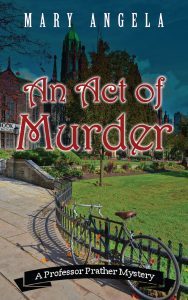 The characters have grown and grown up in many ways. Emmeline is still a young professor, idealistic and passionate. But after three years on campus, she’s expanded her views on relationships and teaching. The lack of funding for the French department, for instance, has led her to pursue another research interest, women’s studies. The new direction drives her to finish her scholarly book in A Very Merry Murder.
The characters have grown and grown up in many ways. Emmeline is still a young professor, idealistic and passionate. But after three years on campus, she’s expanded her views on relationships and teaching. The lack of funding for the French department, for instance, has led her to pursue another research interest, women’s studies. The new direction drives her to finish her scholarly book in A Very Merry Murder.
In the second book, Passport to Murder, Professor Prather had more than one romantic possibility on the horizon. Do we have any romance to look forward to in A Very Merry Murder?
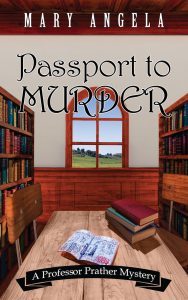 Yes! If you’re the swooning type, you might want to grab your smelling salts for the last few pages. In this novel, Em struggles with her feelings for Lenny when his childhood friend visits Copper Bluff. She also grapples with the idea of mixing work and pleasure. She has a choice to make by the end of book three. Readers might be surprised by her decision!
Yes! If you’re the swooning type, you might want to grab your smelling salts for the last few pages. In this novel, Em struggles with her feelings for Lenny when his childhood friend visits Copper Bluff. She also grapples with the idea of mixing work and pleasure. She has a choice to make by the end of book three. Readers might be surprised by her decision!
Nothing says Happy Holidays like a good murder investigation! What drew you to a holiday mystery?
I’ll admit it: I’m a Christmas fanatic. Those holiday catalogs that come in the mail? I get ten a month and read them all. I also read lots of holiday books. Mooseltoe is my all-time favorite children’s book. It would make a great present for an elementary student.
What is your favorite holiday tradition?
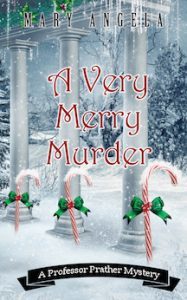 My family and I love traveling to the Guthrie Theatre in Minneapolis to see A Christmas Carol. The tradition began when my husband and I were first married. We attended a performance with my parents. It was magical, and we were hooked. I can still remember the smell of the theater and the color of the robe worn by the Ghost of Christmas Present. Spinning from the ceiling in a twist of green and gold, he reminded me of Santa Claus coming down the chimney on Christmas Eve. By the time Fezziwig’s party arrived, I was officially in the Christmas spirit!
My family and I love traveling to the Guthrie Theatre in Minneapolis to see A Christmas Carol. The tradition began when my husband and I were first married. We attended a performance with my parents. It was magical, and we were hooked. I can still remember the smell of the theater and the color of the robe worn by the Ghost of Christmas Present. Spinning from the ceiling in a twist of green and gold, he reminded me of Santa Claus coming down the chimney on Christmas Eve. By the time Fezziwig’s party arrived, I was officially in the Christmas spirit!
We still make the pilgrimage nearly every year. My eldest daughter and I have birthdays in December, so it’s our gift to each other. There’s no better present than being with family during the holidays.
What are you working on now?
I’m working on book four in the Professor Prather series, Coming Up Murder. Shakespeare’s first folio has arrived on campus, right in time for the reopening of Shakespeare’s garden. Lots of events are planned—including a murder or two!
Final words of wisdom:
Join a professional organization for writers, and learn from it. If you’re isolated from the writing community, as I am, an organization will help you become acquainted with the business of writing. It might also help you make contacts before you need them. After my first book was accepted for publication, I was left scrambling to learn about things I should have learned earlier. Had I known about some of the great organizations like Sisters in Crime, Mystery Writers of America, and Authors Guild, I would have been more prepared for what was to come.
Great advice! Thanks for joining us to celebrate your book launch!
The post A New Holiday Cozy From Mary Angela appeared first on Elena Hartwell.
September 23, 2018
LA to New York City: Best selling author L.A. Chandlar
The Author
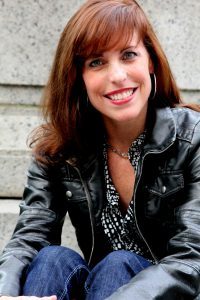 L.A. Chandlar is the National Best-selling author of the Art Deco Mystery Series with Kensington Publishing. Her debut novel, The Silver Gun released August 29, 2017, the sequel, The Gold Pawn, releases September 25, 2018. (Congratulations on the launch!!)
L.A. Chandlar is the National Best-selling author of the Art Deco Mystery Series with Kensington Publishing. Her debut novel, The Silver Gun released August 29, 2017, the sequel, The Gold Pawn, releases September 25, 2018. (Congratulations on the launch!!)
Laurie speaks for a variety of audiences including a women’s group with the United Nations. Laurie has also worked in PR for General Motors, writes and fund-raises for a global nonprofit, is the mother of two boys, and has toured the nation managing a rock band.
For more information, visit L.A. on Facebook, Twitter, Pinterest, Instagram, Goodreads, and YouTube.
The Books

New York City, 1936. In the midst of the Depression, the Big Apple is defiantly striving toward an era infused with art, architecture, and economic progress under the dynamic Mayor La Guardia. But those in City Hall know that tumultuous times can inspire both optimism and danger… 
In The Silver Gun, Lane Sanders, aide to the mayor needs to solve the mystery of her past with the current threat to the mayor before someone pulls the trigger on the most explosive revenge plot in New York history.
In The Gold Pawn, when two crimes converge, judging friends from enemies can be a dangerous game.
To purchase the books, click the link here.
The Interview
How did your experience of writing a novel change between writing book one and book two?
Well, for me, the biggest change was between books two and three. When I was first writing The Silver Gun and going through the agent search process, I didn’t stop while I searched. I kept writing because I love the books and the characters so much. I had to find out what happened next! I wanted to write the sequel because I’d not only have more to offer a prospective publisher (i.e. not working for ages on ONE manuscript), but I knew it would inform the first and I’d learn a lot.
So when I got my publishing deal, it was for three books and I’d had two of them written, just needed editing. Writing the third, The Pearl Dagger, which releases in 2019, was the biggest change because I wrote the whole book in that one year. It was fun, but I had to be more mindful of my writing habits and the deadline. The biggest tip I learned was to actually turn off the word and page count. When I was nearing the end, I started focusing on those annoying numbers instead of the content of my chapters. It was paralyzing. When I turned them off, I wrote a lot more and wasn’t impeded by anxiety.
Writing a historical novel can require a lot of research. What is your process for creating a world set in New York City in 1936?
I read a lot of books about the era, especially about Mayor La Guardia. I look at photos and a lot of books on Art Deco. The best find -ever!- was a book by Hulbert Footner, New York: City of Cities, published in 1937. It’s a long, poetic, wildly descriptive tour book of the city. But not just to the tourist sites, but to the NYPD and the mayor’s offices. What was incredibly helpful, was that it was set right in my time without any tainting from hindsight.

They were in the era, between the two world wars, living in the present. I use that book like it’s the Bible. I also take a lot of notes with any tidbit I pick up, and I talk with a lot of people who remember La Guardia or have a relative who told them stories. I often interview them and get those juicy pieces of history that really make a time come alive or show a side to the era or La Guardia that people don’t often get to see.
That’s my favorite part: illuminating parts of the 1930s that challenge the general narrative that we usually hear about. The creativity, humor, and art of that time period can often be overshadowed by the Depression.
Tell us about Brass: Fight to Keep Creativity Alive:
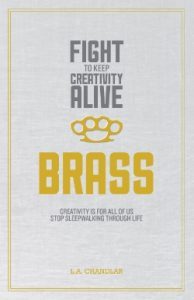 When I finally started to take writing seriously (setting aside small increments of time that I did consistently), I had SO MUCH FUN! I was filled in ways I hadn’t been in a long time. Every friend I came across would ask why I was looking so enthused, and I told them about writing. In response, every single person would say something wistful like, “Oh I remember when I used to fill in the blank.” Garden, read for pleasure, do photography, crochet, paint with watercolors…
When I finally started to take writing seriously (setting aside small increments of time that I did consistently), I had SO MUCH FUN! I was filled in ways I hadn’t been in a long time. Every friend I came across would ask why I was looking so enthused, and I told them about writing. In response, every single person would say something wistful like, “Oh I remember when I used to fill in the blank.” Garden, read for pleasure, do photography, crochet, paint with watercolors…
I began to think through why, when life gets complicated, do we relegate creativity to superfluous hobby status? When it seems to me so much more important than that… So I started writing articles about the psychology of creativity, the myths that we tend to believe, how life is always complicated so you still need to do the critical things…
And then it morphed into Brass and my workshops that I offer on the topic. The reason it’s called Brass and why my logo has brass knuckles and switch blades on it, is that creativity doesn’t just happen or come without effort. You have to fight for it! And it has so much more bite than just a hobby. It brings us life and helps us in every other area of our lives.
The Gold Pawn continues the story of Lane Sanders. What challenges did you find (and are you finding in three) to build a character arc in an existing character? Was it an advantage or disadvantage to work with the same protagonist?
This one, The Gold Pawn, was easier for creating the arc because I knew a long time ago that Lane had issues to face with the loss of her parents. I have friends who have lost parents, and I know how long that can take to embrace and there are so many levels to that grief. Plus, Lane has a lot of intrigue in her life. Lane is a positive, smart, funny person who is mainly level-headed. But in The Gold Pawn she wrestles with her fears and her indignity that her parents left a horrible void.
She wonders who exactly she can trust in the midst of a complicated mystery that has her questioning her own judgment. But most importantly, she wrestles with wondering if she can trust herself… In book three, coming out next year, The Pearl Dagger, Lane grows because it’s Finn’s turn to face his past. With these bigger themes that are driven by the mystery as well as a plotline I’ve had for a long time, it’s been fun to watch them grow. But I’m a big learner myself. I love to figure out things, what makes a person tick, and the obstacles to overcome situations. So I guess I bring in a lot of my own observations as I personally grow, so that helps immensely in character arcs.
What are you working on now?
Book 4! Yet to be named… But I do know that this one will take the crew back to Detroit where they will see first-hand the repercussions for Detroit’s big business during Prohibition earning its moniker: Whisky Town. And it will have a HUGE piece of explosive history and perhaps an age-old question will be answered as the book’s timeline approaches May of 1937…
Fascinating! Looking forward to your next books – and having you back on my blog to share with readers.
The post LA to New York City: Best selling author L.A. Chandlar appeared first on Elena Hartwell.
September 16, 2018
New Books, Debut Authors, Plus Series Author Matt Goldman
The Author
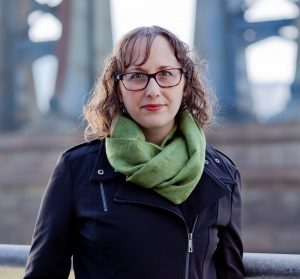 Kit Frick is a novelist, poet, and MacDowell Colony fellow. Originally from Pittsburgh, PA, she studied creative writing at Sarah Lawrence College and received her MFA from Syracuse University. When she isn’t putting complicated characters in impossible situations, Kit edits poetry and literary fiction for a small press, edits for private clients, and mentors emerging writers through Pitch Wars.
Kit Frick is a novelist, poet, and MacDowell Colony fellow. Originally from Pittsburgh, PA, she studied creative writing at Sarah Lawrence College and received her MFA from Syracuse University. When she isn’t putting complicated characters in impossible situations, Kit edits poetry and literary fiction for a small press, edits for private clients, and mentors emerging writers through Pitch Wars.
Her debut young adult novel is See All the Stars (Simon & Schuster / Margaret K. McElderry Books, 2018), and her debut full-length poetry collection is A Small Rising Up in the Lungs (New American Press, fall 2018). A second YA novel, All Eyes on Us, will follow in 2019.
For more information about Kit, you can find her on Twitter, Instagram, Pinterest, and Facebook
The Book
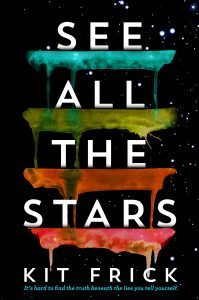
See All the Stars is a story about first love and big loss and even bigger guilt—and an epic breakup between best friends. The story takes place in two timelines that alternate between the past and present as Ellory tries to focus on her future. It’s a contemporary suspense about accepting responsibility for the things you can’t change and then learning to move on.
You can find the book on Amazon, Barnes & Noble, and IndieBound
The Interview
Describe your publishing journey:
I had years of writing and publishing poetry under my belt before I got serious about writing fiction, which was a challenge I’d been fascinated by—and terrified of—for ages. I got the idea for See All The Stars in late 2014 and spent all of 2015 drafting and then revising with the help of beta readers. It was the second novel I’d written; the first manuscript was an ill-timed and ill-fated dystopian that I didn’t seriously query. (Only one?!?! That’s fantastic! -E)
I queried See All the Stars for about three months and received three offers of representation. Once I signed with my agent, Erin Harris at Folio, we dove into further revisions before putting the manuscript on submission. See All the Stars sold to my editor Ruta Rimas at S&S/McElderry in October 2016. And twenty-two months later, See All the Stars hit shelves on August 14 of this year!
What inspired you to write this novel?
I’m drawn to complex characters, and my writer-brain delights in putting them in very tough situations and empowering them to dig their ways out. The idea for See All the Stars began with a “what if?” question: What if a girl lost all her friends and her boyfriend in one fell swoop—and what if she was partly responsible for what happened? Ellory’s story unfolded from there.
What are you working on now?
My next book is another stand-alone YA thriller, called All Eyes on Us. It’s about two girls under unbearable pressure from their families and communities—and what happens when an anonymous texter threatens to uproot their lives. I turned in copyedits over the summer and should be seeing page proofs soon—very exciting! All Eyes on Us is scheduled to release in May 2019, also from S&S/McElderry, and I’ll be able to share a lot more later this year!
Fabulous! Looking forward to hearing more. Thanks for hanging out with us.
The Author
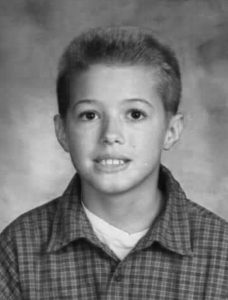
Tristan Drue Rogers continues to misspell his middle name despite it appearing that way on his birth certificate. He is a husband and an author. A self-described “ever-student,” Tristan prefers to learn as opposed to master, disbelieving in absolutes.
His stories, especially his characters, represent this idealogy well, with a keen commentary on the lives of people today, he attempts to bridge the old with the new, the fantasy with reality, the anxiety with heroism, and the horror with beauty. Deepening wounds and reevaluating their power is the name of the game. His recently released novel Brothers of Blood is available anywhere books are sold.
The Book
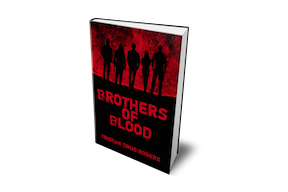
A band of merry murdering highschoolers decide to make senior year the ride of a lifetime by stalking their least favorite individuals. While a knock from an unexpected visitor swerves the boss’s plans, dissention in the ranks causes a commotion that may truly test her hold over it.
Laugh, cringe, and cry as Belle Whynecrow leads this unlikely brotherhood into a series of terrible crimes that will shock and awe you in Brothers of Blood.
The Interview
Describe your publishing journey:
The way that I discovered my publisher Black Rose Writing was a pretty perilous journey for me. Two years had went by after the five year ordeal that was writing it. After so many rejections, I honestly felt that I was never going to be able to find someone to read it, let alone publish it. A simple bit of serendipity hit me when my girlfriend at the time, now my wife, Sarah, had mentioned my story to a co-worker and he apparently was a writer as well.
This is the horror author C Derick Miller, who told Sarah to give me his email. After years of being on the verge of giving up, Miller shot me with a jolt of lightning that reenergized me by giving me information for a now defunct literary agency that was able to, as their last act as an agency before closing, find me a publisher in Black Rose Writing. I was lucky as all can be for the entire experience.
What inspired you to write this novel?
So many things inspired this novel. I wanted to make a hip hop concept album, but in book form. This is sorta my Marshall Mathers LP, I guess. Of course, as I wrote the beast, I became inspired by so much more, 20 pages in I couldn’t stop. Then by 100 it really feels like it could be something until you realize you’re nowhere done and then the story needs an end, so you march on.
It was a heck of a ride. Mostly, I wanted to write a novel where the characters speak the way my friends do. I think I did that. The world isn’t as it seems and the child that I was before this book was written – years before – was sure that it was filled with evil of the worst kind at every corner. Writing BOB helped me let that part of me and my past go. Or I hope it did.
What are you working on now?
I am working on a billion short stories, but my main focus has been a political novel based about 20 years into the future. It focuses upon an America where kings have been recently reinstated until some big hullabaloo happened and just as quickly the presidential format of ruling government was welcomed back. It stars a young black man working his way through school in North Texas and his struggles living in a world of fallen kings, royal or otherwise. It’s been a real headache!
It may be a headache, but it sounds fascinating! Keep us posted.
The Author
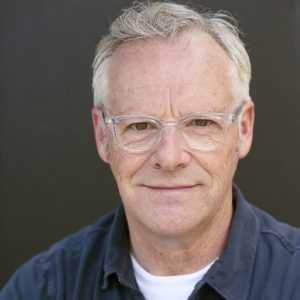 Matt Goldman is a New York Times Best Selling author and Emmy Award winning TV writer. His debut novel. Gone to Dust has been nominated for The Nero Award and a Shamus Award.
Matt Goldman is a New York Times Best Selling author and Emmy Award winning TV writer. His debut novel. Gone to Dust has been nominated for The Nero Award and a Shamus Award.
Matt’s television credits include Seinfeld, Ellen, The New Adventures of Old Christine, and Dirk Gently’s Holistic Detective Agency.
Learn more about Matt on Twitter, and Facebook
The Books
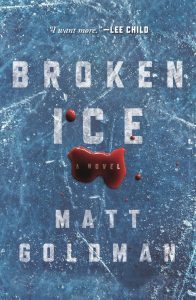 “Private-eye novels can be an acquired taste. Not so with Gone to Dust, the captivating debut of Seinfeld screenwriter and part-time Minnesotan Matt Goldman… This Scandinavian noir page-turner proved so popular that Goldman already has a second novel, Broken Ice, set for release this summer, and a third for 2019.”
“Private-eye novels can be an acquired taste. Not so with Gone to Dust, the captivating debut of Seinfeld screenwriter and part-time Minnesotan Matt Goldman… This Scandinavian noir page-turner proved so popular that Goldman already has a second novel, Broken Ice, set for release this summer, and a third for 2019.”
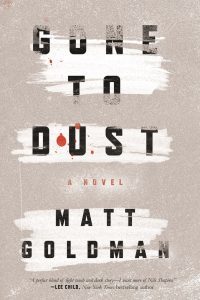
—Minneapolis-St.Paul City Pages, “Best Book of the Twin Cities”
“A clever mystery that starts with a unique crime scene, mixes in a package of red herrings, and tops off the plot with Nils Shapiro.” (Broken Ice)
—Phillip Margolin, New York Times bestselling author
“With his wry, observant eye and quick wit, plus a pressing need to follow the truth into dark, uncharted places, Shap is a more optimistic version of Ross MacDonald’s Lew Archer. Readers will look forward to his next investigative adventure.” (Gone To Dust)
—Publishers Weekly
Buy the books: Gone to Dust & Broken Ice
The Interview
How did your experience of writing a novel change between writing book one and book two?
My experience changed in two ways. On book one, Gone to Dust, I was thrilled to create new characters and simply to be writing a novel. I also had four months uninterrupted, so I could live, breathe and sleep the story. It was a luxurious process. I felt more responsibility on book 2, Broken Ice. Responsibility to readers, the characters, and to my publisher, who had contracted for the book before I wrote it.
I was also working full time on a television series while writing Broken Ice, so I had to juggle time and creative space. And I didn’t want to repeat Gone to Dust, so I moved my characters forward in their personal lives, and told a different kind of story. I felt more like a professional writer on Broken Ice, and that really helped my approach to book 3, The Shallows, which will be published in June, 2019.
You wrote for television prior to launching your first novel, how different are those processes? What did television teach you about writing a novel?
Television writing helped me a great deal. I learned character, story, relationships, dialogue, and series architecture. I worked in rooms of talented writers and benefited from their knowledge, style, and experience. The processes are quite different. In TV, you get constant input from other writers, producers, actors, directors, studio and network executives. It’s easy to lose the thread of your original idea, for it to get transformed into something else, and that something else usually isn’t for the better because the voice gets watered down or lost.
In TV, I had to expend a great deal of energy to answer other people’s notes. Sometimes they were good notes, sometimes not. But it left me little time to answer my own notes. Or to sit with something long enough to realize what I felt needed improving. In novel writing, it’s all the author, at least for a few drafts.
Your first novel, Gone to Dust, was nominated for both a Shamus and a Nero and made the NY Times Best Sellers list. How much pressure has that early success put on you as you write your next book(s)?
It hasn’t put much pressure on me. I have an intrinsic drive to work hard on my books. I’ve also been around writing and awards and television long enough to know accolades come when they come—you can’t chase them. I’ve seen plenty of writers chase awards and popular reception—it doesn’t go well. A writer’s job is to keep their head down and write. Some books or shows or episodes will be hits. Others won’t be. The important thing is to keep writing. (Great advice, Matt!)
Broken Ice continues the story of Nils Shapiro, private detective. What challenges did you find to build a character arc in an existing character? Was it an advantage or disadvantage to work with the same protagonist?
I love series. I love reading them and love writing them. It’s a joy to build characters who live and breathe and grow. The challenge in my series is they’re narrated by one person, Nils Shapiro, my protagonist. So I’m in his head the whole time. I like being there, but I don’t want it to get old for the reader. I have to work to develop stories and other characters that push Nils forward.
What are you working on now?
I’m just finishing a second draft of a stand-alone set in 1922. It’s about an extended family who loses their liquor business to Prohibition, and how they cope with that loss. The Eighteenth Amendment created strange allies. For instance, suffragettes found themselves on the same side as the KKK, who were against alcohol for different reasons. The suffragettes fought the damage alcohol did to families. The KKK hated African Americans, the Irish, Italians, Jews, Slavs, and others and wanted to criminalize their traditions.
The Nineteenth Amendment also created an interesting dynamic. Women won the vote but they had just begun the fight for equality in the home. Crime and criminals are a tangential element in this book, and I have no idea if it will get published. Next month I’ll start writing the fourth Nils Shapiro book, which will be published summer of 2020.
I’m thrilled for your continued success, Matt! Thanks for spending time with us here today.
Header Photo from Pexels
The post New Books, Debut Authors, Plus Series Author Matt Goldman appeared first on Elena Hartwell.
September 9, 2018
To Query or not to Query . . .
Following up on my blog post about Publishing Basics, which covers the “three” tiers of the publishing world, I wrote about the differences between editors and agents and PR groups. In The Query Letter post, I covered some basic tips for writing a solid query letter. Today I want to talk about one of the hardest questions a writer faces. Am I ready to query?
Am I ready to query?
“Writing” is an art, a craft, and a business. When people ask what it takes to be a “writer,” the easy answer is sit at your (desk, table, counter) and use your (pen, pencil, computer) to write a story. What they really want to know is: 1. How do you come up with ideas? 2. How do you write an entire novel? 3. How do you get published?
#1 is easy for most of us. Ideas are rarely the problem. Honing in on one may be a challenge, but we find ideas all around us.
#2 requires dedication, determination, and an endless capacity for knowing that no matter what happens, you can’t stop. This is where the magic of creation meets the complexities of craft. But it’s one we can all do. It doesn’t require a degree, money (though it helps to be able to go to conferences and take workshops!), or any special equipment. All it requires is tenacity.
#3 is the first part of this equation where a writer has limited control. You can control what you write, you can’t control who wants to buy it. You are in charge, however, of the submission process. At least in terms of putting your work out there. Which brings us to today’s post. How do you know when you’re ready.
While each writer is unique and every manuscript a different journey, there are a few boxes we can all check off before we start submitting our work to agents or editors. I’m going to discuss six questions you may want to answer (truthfully!) before you start the query process.
1. How many drafts have you done on your own?

If the answer is one, you aren’t ready to query. If the answer is: I’ve done so many drafts I can’t count them all, you may be getting closer. So what is the “right” number? That depends on multiple variables, but I can give you a quick rule of thumb, if you read your manuscript and can still make changes, you aren’t done rewriting.
If you can go through a draft, reading closely, and you can’t find a single thing to change . . . you have done what you can do for the current draft. Now would be a great time to get beta readers, enter competitions, awards, meet with agents at conferences, or hire a professional editor. But at least you can check this box off the list!
2. Have you read it on a hard copy?
 The mind works differently reading a computer screen than reading from a hard, paper copy. We see things on a paper copy we won’t catch on a computer screen. When you think you are “done,” set the manuscript aside for a week or so, then print it out and read a hard copy. Make notes on the copy. Then after reading through the entire manuscript, go back to the computer and make the edits/changes/add or cut material. After that process, read it again on the screen.
The mind works differently reading a computer screen than reading from a hard, paper copy. We see things on a paper copy we won’t catch on a computer screen. When you think you are “done,” set the manuscript aside for a week or so, then print it out and read a hard copy. Make notes on the copy. Then after reading through the entire manuscript, go back to the computer and make the edits/changes/add or cut material. After that process, read it again on the screen.
Reading the entire manuscript out loud can help you catch mistakes as well. Keep in mind, if after doing this, you’re still making changes, you aren’t finished! Don’t forget that first box, “can I still find changes to make.”
3. Where have you gotten feedback?
If you are an early career writer, or this is your first book-length work, it’s a safe bet your manuscript could be improved with critiques from outside eyes. The tricky part is whose. Writer’s groups are fine, but there are a few things I would caution writers about with feedback from other (unpublished) writers. First, you want to be the worst, least experienced writer in your group.
While other new authors can be very useful, and give solid feedback, you are better off if at least one of the members of your group has published, preferably in your genre. Obviously, if someone in your group is a creative writing teacher, a professional editor, or works in the industry, that’s great. But make sure you are getting feedback from someone with credentials. Second, genre. There’s nothing wrong with people who write and read different genres providing suggestions to improve your work. But be aware of whether or not suggestions fit into the genre you’re writing. A romance writer may not give you constructive feedback on your horror novel, simply because they don’t understand how your genre works. More importantly, they may miss something important, because they aren’t familiar with the genre you write in.
Lastly, “group” feedback can make your work start to feel muddy if you try to make everyone happy. Don’t let too many chefs get their hands on your stew. My suggestion is to choose one person to read the full manuscript, not the entire group. Or at least one at a time, so you can take in suggestions, rework the draft using the feedback that feels correct for you, then have another reader critique. Often the least polished material I read when working with a client, is a first chapter that has been “critiqued” over and over by a group. (5 & 6 below provide more information about feedback).
4. How much time between finishing a draft and doing a final read through?
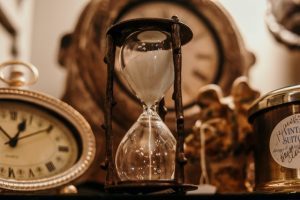 As hard as waiting is, time can be your friend. By reading drafts back-to-back-to-back, we can miss problems that we would catch with a little “distance.” Taking time off between drafts allows your mind to focus on other things for awhile (work on another manuscript or a short story). When you return to the manuscript, it’s easier to find problems instead of having your creative mind fill in the holes without you realizing they exist.
As hard as waiting is, time can be your friend. By reading drafts back-to-back-to-back, we can miss problems that we would catch with a little “distance.” Taking time off between drafts allows your mind to focus on other things for awhile (work on another manuscript or a short story). When you return to the manuscript, it’s easier to find problems instead of having your creative mind fill in the holes without you realizing they exist.
Shifting between the creative side and the editorial side (yes there’s cross over, but you understand the distinction I’m making, right?) requires focus. Learn to read like an editor. Take enough time off that you can set aside your emotional response to your own work and look at it critically. Make sure you have at least a week after your last rewrite before you read that one last time, and if you don’t make any changes, you can check off this box too.
Photo by Jordan Benton from Pexels
5. Have you considered competitions, awards, and professional feedback
There’s nothing to lose by trying your material out through submitting to competitions, awards, or professional feedback. Always read the fine print (if the competition wants control of your rights etc. don’t do it!). There are a lot of great awards out there, which come with a step up on the publishing ladder. For example, some come with a publishing contract, agent introductions, or feedback from professional readers. Lastly, there are different ways to get professional feedback. Conferences often host one-on-one sessions with authors, agents, and editors.
Critiques run anywhere from the first page to the first 50+ depending on the specifics. Conferences often offer paid critiques with experts. If you are an early career writer, I highly recommend trying a few of these. Get a sense of how someone in the industry receives your work, even if it’s only the opening chapter. If they say you aren’t ready yet, consider taking more workshops, reading more craft books, or finding classes through writers groups or community colleges. Lastly, you might consider #6 and hire a freelance editor.
6. Can you hire a professional editor
 If you have done all the drafts you can, received feedback from all the qualified readers you know, and you want to get a leg up on the other first time writers in a slush pile, you can hire a freelance editor. Working on a manuscript for queries, I would highly recommend a developmental editor. Someone who will read through the full manuscript and help you with character and story arc, convincing dialogue, find your writing “tics,” and help with the larger picture issues.
If you have done all the drafts you can, received feedback from all the qualified readers you know, and you want to get a leg up on the other first time writers in a slush pile, you can hire a freelance editor. Working on a manuscript for queries, I would highly recommend a developmental editor. Someone who will read through the full manuscript and help you with character and story arc, convincing dialogue, find your writing “tics,” and help with the larger picture issues.
For writers who want to self publish, after the developmental editor, I highly recommend also hiring a copy editor. Someone to go through line by line and check your grammar, spelling, and style types of mistakes. Traditional publishers will put a manuscript through various rewrites and passes by professional editors. If you want to self publish, recognize you need at least as much assistance in this area as traditionally published authors.
Obviously, the ability to hire a freelance editor will depend on your financial situation. But keep in mind, you only get one shot with an agent. You’ve put months if not years into a manuscript, what is it worth to you to make it the best it can be? Even published authors sometimes work with professional editors before their new work goes to agents or their publisher. Consider it an investment in your writing career.
Photo by rawpixel.com from Pexels
Don’t rush to submit just because you type “THE END.” You may not be finished, but you are on the road. Be proud of what you have accomplished. Then roll up your sleeves and get back to work!

The post To Query or not to Query . . . appeared first on Elena Hartwell.

